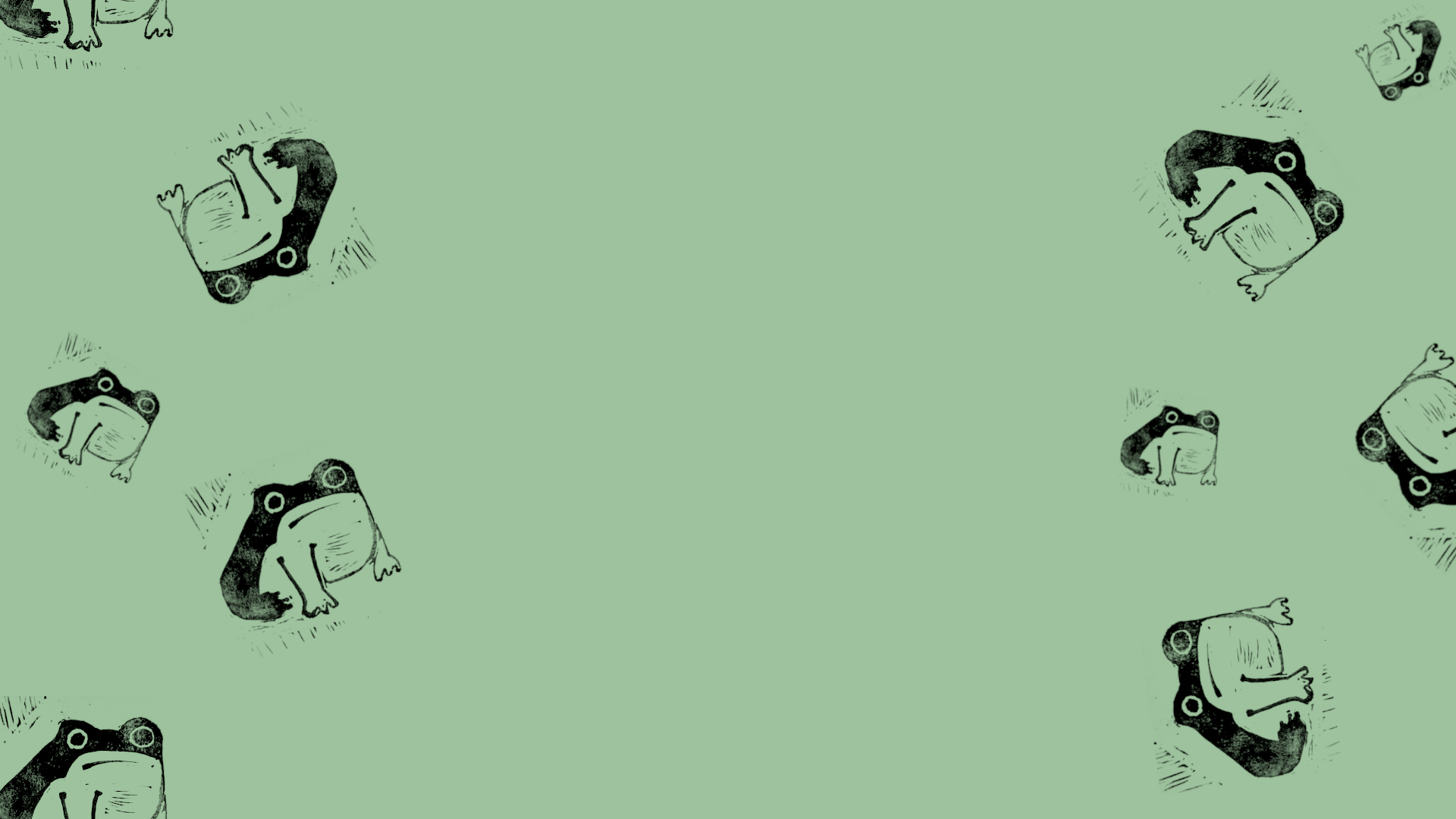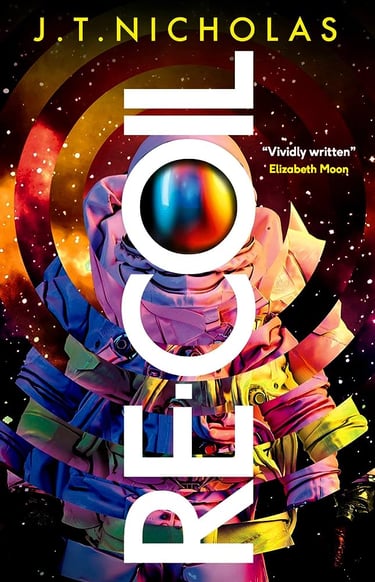
Review: Re-Coil by J.T. Nicholas
what happens when your brain's in the cloud and space zombies are trying to eat your crush
BOOKSREVIEW

Lack of development is a big problem with Re-Coil. Carter and Shay see little development as characters, even after learning that the world is threatened by a zombie virus and that their mission may determine the course of all humanity. Neither is honest about their feelings towards each other, and they never are faced with obstacles that challenge their world views in a meaningful way. For a story that carries such a strong emotional undercurrent through Shay’s dysmorphia, there’s agonizingly little emotional depth otherwise. Even the addition of Korben, a charming and lethal enemy assassin turned ally, doesn’t spur any real change of heart or growth for Carter nor Shay (though he does inject the story with a much-needed dose of fun).
When brain back-ups turn humanity into a nearly-immortal race, one of life’s greatest worries becomes the body one’s consciousness will be reuploaded into. Bodies are a commodity. Not every insurance plan guarantees its policyholder will end up in a body they’re comfortable in– not even their preferred sex. It’s a capitalist twist on a utopian concept, clever enough to build a whole world around and smart enough to drive a deeply personal story about gender, identity, and sexuality. But, disappointingly, Re-Coil turns into a shamblingly slow-paced cyber-zombie adventure that eats away all of the potential of its humantity-minded concept in favor of drawn-out action sequences and exasperating exposition.
Re-Coil is brimming with great ideas. Its opening sequence, an investigation of a derelict craft as it drifts towards the sun, does a good job at establishing the cold realities of backed-up brains and the world they’ve created, complete with AI assistants and cybernetic implants. After our protagonist, Carter, meets his sudden demise while scavenging the ship, he wakes up in a new body some months later and immediately finds himself under attack by an assassin. It becomes obvious that he stumbled upon some big secret on that derelict craft. Except, that version of Carter is dead, and so the new one doesn’t have any idea what his former self saw or why he’s being hunted. It’s a fun twist on classic noir writing that gets the plot moving in a familiar way while also fleshing out Re-Coil’s world.
Where Re-Coil really misses is in its plot and pacing. What begins as an exploration of identity and gender, looking at how life goes on when no one can truly die, ends up turning into a schlocky cyber-zombie story. Now, don’t get me wrong: I love a good, schlocky zombie story. But this novel seemed like it was going in a much, much different direction than that. It felt smart and intimate. And the moment it becomes a zombie story, the zombie plot takes over so fully that all of the emotional depth the novel began with gets overrun by chapters and chapters of zombie fighting. It’s maddeningly slow-paced zombie fighting, too– slow-paced to a numbing degree. The chapters drag on, the whole conflict far-too drawn out to the point where I was tired of the whole thing and excited for it to wrap up. What’s even worse is that this zombie fight accounts for about one-third of the novel’s full 353 pagecount, making it an unfortunately substantial portion of the story.
The novel’s first half stays strong as Carter begins scouring the solar system for his lost crewmates. He flies from one space habitat to another until he finds Shay, the alluring tech wizard gal Carter has always had his eye on. But when Carter finds Shay, he learns that she’s been re-coiled (the term for one’s mind being uploaded into a new body) into a bio-male body. Shay experiences intense dysmorphia with her male form. She’s beside herself with grief and is deeply uncomfortable inside such a masculine body. Despite this, Carter never loses his eye for Shay. He sees her femininity in every smirk and sly look she gives him and can’t deny his fond feelings for her. Shay’s dysmorphia, coupled with Carter’s undeterred interest in her, makes for an interesting exploration of gender and identity as well as romantic attraction.
Unfortunately, Re-Coil’s exploration doesn’t extend much further than this initial presentation. Shay and Carter are both keenly aware of Shay’s dysmorphia. Neither shy away from the topic throughout the course of the novel, instead using it as a driving factor for their deal with the shady Genetechnic in the novel’s second half. Despite Carter’s pinings and Shay’s obvious reciprocation of Carter’s feelings, their relationship sees no development. I was hoping for their romantic feelings to blossom more fully by the end of the novel, but it’s not until Shay is re-coiled into a bio-female body that any progress is made. By which point, the most compelling aspect of their relationship has passed with neither party fully acknowledging it. This felt like a missed opportunity to more deeply explore the story’s social themes in a manner unique to Re-Coil.
Besides the fighting, an unnecessary level of exposition also pulls down the pacing. There are pages of exposition about the governing bodies of space habitats and Martian colonies, about the design principles that guide architecture beyond earth, and the scientific workings of corporate security systems. Now, like schlocky zombies, I love me a well-built world, (hell, I like a lot of the worldbuilding in Re-Coil), but few novels demand their world to be explained in intensely, exhaustingly granular detail, and Re-Coil is not one of them. When the novel regularly interrupts its own dialogue in order to go in on exposition that didn’t really need to be explained, it quickly becomes overbearing. Not only that, but Re-Coil is also guilty of repeating the same exposition several times over, making absolutely certain readers know how a body is re-coiled. It’s too much. At least one entire chapter was fully expositional– unnecessary exposition at that. Too much.
Re-Coil is a novel that’s built on an interesting concept that it uses to explore important themes. I was really excited to see where the story would go and how its characters would deal with the lots handed to them by a godlike Big Pharma corporation that controls both life and rebirth. But Re-Coil’s ultimate lack of character depth, sluggish pacing, and long-winded exposition makes it shamble along almost as mindlessly as the zombies that threaten its world.


A killer concept
The cover art for this novel is absolutely gorgeous. Designed by Vince Haig
Moving at a shamble
Final Thoughts:
Re-Coil is disappointingly just okay.







Stick around and read some more stuff!

Get in touch!
Contact me directly :)
joelatroutman@gmail.com
Or use this form thing!


